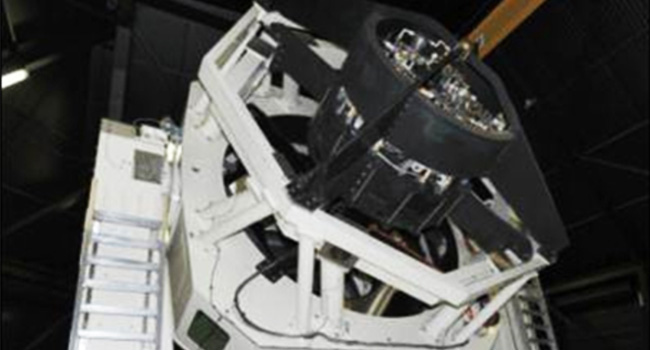
A giant telescope designed to monitor and intercept threats from deep space and track low earth orbit satellites and space junk will be installed at the Harold E Holt Naval Communications Station in Exmouth, Western Australia.
The 80-tonne Space Surveillance Telescope (SST) and radar system will be transported from New Mexico in the US and come online in WA by the end of 2016. The federal government will spend $63 million to build an enclosure facility around and provide operational support, beginning work by mid-2015.
The telescope and radar – which the US will relocate and still own – will track, classify and identify floating space junk and act as a sensor in the US Global Space Surveillance Network, which could include pinpointing the launch and location of Chinese satellites and missiles.
Richard Tanter, Senior Research Associate, Nautilus Institute for Security and Sustainability and Professor, School of Social and Political Studies at University of Melbourne has been reported as saying that there are now large numbers of Chinese military intelligence, communications, and global positioning satellites in geo-synchronous orbits (GEO).
While US radars can detect objects in GEO, it is time consuming and difficult and telescopes do a better job.
In a statement to the Parliamentary Standing Committee on Public Works about the telescope in August, the Department of Defence said the telescope was needed to boost Australia’s ‘space situational awareness’, to detect space debris and enable it to manoeuvre spacecraft and satellites to avoid collision, but it also admitted military tactics were at play.
“From a military perspective, commanders and decision-makers use Space Situational Awareness to leverage the capabilities of space-based systems while exploiting the associated vulnerabilities of an adversary,” Defence said in evidence to the Committee.
Government News understands that the trajectory of any Chinese satellite launches would be likely to come down over WA and the SST would be able to identify what satellites were being launched.
The SST will also track, identify and classify space junk, joining the recently launched Cooperative Research Centre (CRC) for Space Environment Management at Mt Stromlo, ACT which performs a similar function.
Professor Andrew Dempster, Director of the Australian Centre for Space Engineering Research (ACSER) at the University of New South Wales said that the SST would help predict the orbit of space junk but it couldn’t pick up everything.
“The problem we have got is that from the Earth using radars like this (is) you can track objects up to about 20cm in diameter travelling at kilometres per second. Our evidence of satellites having impact damage is being hit by small debris,” Prof Dempster said.
“They move space stations and other satellites so that they can avoid collisions. That’s very difficult to predict exactly where the debris is going to be. These radars track them and then you have to predict their orbit.”
Prof Dempster said that Australia had few satellites and none down low where the space junk was.
Dr Ben Greene, the Chief Executive Officer of the CRC and CEO of Electro Optic Systems in Mount Stromlo, which is supplying lasers to the Exmouth telescope, said earlier this year there were more than 300,000 items of debris orbiting the earth.
“There is so much debris that it is colliding with itself, and creating more debris. A catastrophic avalanche of collisions which could quickly destroy all orbiting satellites is now possible,” Dr Greene told the Australian Broadcasting Corporation.
“Our initial aim is to reduce the rate of debris proliferation caused by new collisions, and then to remove debris using ground-based lasers. Preliminary research has been performed by the individual CRC participants over the past decade, and we will now work together in the CRC to drive the program forward,” Dr Greene said.





Leave a Reply